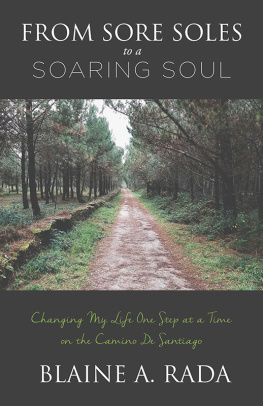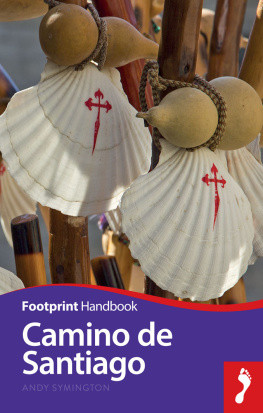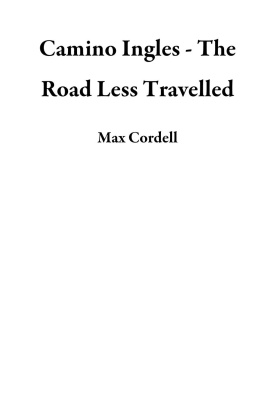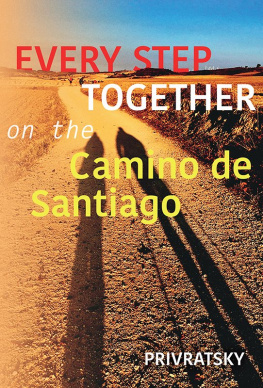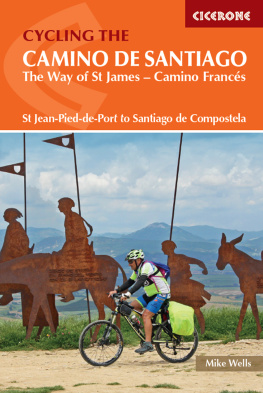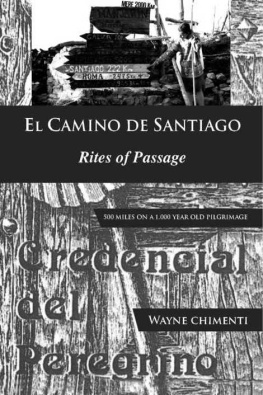The Call of the Camino
EACH STEP
is the
JOURNEY
Patricia A. Klinck
Copyright 2013 Patricia A. Klinck
All rights reserved. No part of this publication may be reproduced, stored in a retrieval system, or transmitted in any form or by any meanselectronic, mechanical, audio recording, or otherwisewithout the written permission of the copyright holder, or, in the case of photocopying or other reprographic copying, a licence from the Canadian Copyright Licensing Agency.
Published in Canada and the United States by Kingsley Publishing
www.kingsleypublishing.ca
All names except the authors have been changed. The places, events, and dialogues are real and as remembered.
Cover and interior design and map: Dean Pickup
Front cover image: Dreamstime
Printed in Canada by Friesens
Distributed in North America by Alpine Book Peddlers, Canmore, Alberta
www.alpinebookpeddlers.ca
2013/1
First Edition
Also available as an ebook
Library and Archives Canada Cataloguing in Publication
Klinck, Patricia A., author
Each step is the journey : the call of the Camino / Patricia A. Klinck.
ISBN 978-1-926832-21-0 (pbk.)
1. Klinck, Patricia A.TravelSpainCamino Francs.
2. Camino Francs (Spain)Description and travel.
3. Christian pilgrims and pilgrimagesSpainCamino Francs. I. Title.
DP285.K55 2013 914.6'11 C2013-903566-4
E-book by Human Powered Design
ISBN 978-0-9921161-0-1 (ePub)
ISBN 978-0-9921161-1-8 (mobi)
FOREWORD
The Camino de Santiago de Compostela is a network of pathways that pilgrims have followed for more than one thousand years. They come from all over the world to Santiago, a medieval city in northern Spainninety kilometres from the Bay of Biscay and ninety kilometres from Finisterre on the Atlantic coast. Before the Christian era, ancient peoples held Finisterre, the mythical end of the world, to be sacred.
Santiago is named for the apostle St. James the Greaterlater known as Matamoros, slayer of the Moorswhose bones are believed buried in the cathedral. Therefore, since the Christian era, pilgrims have believed they can bury their sins at the cathedral by doing a pilgrimage.
Over the centuries, Santiago and the pilgrimage routes developed importance for religious, economic, and political reasons. As rumours spread that the bones of St. James were entombed in the cathedral, the church seized the opportunity to extend its power and authority. It took over the protection and care of pilgrims and traders as a rationale for being there. Churches, convents, monasteries, and hospitals were built along the route. A university established in Santiago became a centre for learning and the arts.
The roads leading to Santiago became politically strategic. They were positioned to hold back the Moors who were pressing from the south and east, and the Franks who raided from the north. Increased population led to the growth of trade. Business flourished. The establishment of a mint signalled the areas economic importance.
Once over the Pyrenees, the Camino turns west and wends its way through parkland to the vineyards of Pamplona, then through the woods of Holm oak and on to Logroo, the city of Rioja wines. Just before Burgos is the archaeological site of Atapuerca where the bones of the first Europeans are located. Len is on the meseta , a vast flat prairie. Then the route climbs through the Montes de Len down to Galicia and finally to Santiago.
Pilgrims still walk the pilgrimage route and in increasing numbers. They come on horseback, on bicycle, and on foot. They walk the entire route or portions of it according to time available and endurance. Albergues are traditional accommodation. Situated about every ten kilometres they support the daily walking rhythm. They are like hostels, with bunk beds, showers, and some minimal cooking facilities. Along the way are a variety of inns, restaurants, and markets where a wide selection of foodfrom sandwiches to mealsis available. For those who want more luxury there are small inns, casas rurales , and hotels.
But these are pragmatic notes for the reader. At its very essence the Camino is about identity. Common wisdom has it that we each walk our own Camino. Our perspectives are shaped by our genetics, by our experiencesand, yesby our karma. The rhythm of one step after another for four to eight hours daily creates a space for thinking and a revised understanding of time. Time is related to space. Some people walk faster than others; some can keep a pace for only three or four days. Some slow their pace to walk with others. Most people opt to walk alone, joining others from time to time, but not feeling responsible for the other. We are alone in this journey, this life.
On the Camino, as in our daily lives, most of us expect that tomorrow will be easier, better, more. It might be. It might not be. We expect well get stronger as we walk. We might. But our weaknesses might weaken us even more. We come to recognize that today, this moment, might be the best there is.
Along the way we become aware that millions have travelled this Camino. We meet an array of people. They fall behind or move ahead of us. Some come back and some dont. Just as in life. Do we make those decisions? Do we choose? Are they part of our story that is given to us at birth?
As we walk, we come to see nature as our context: the brisk air of the mountains, the heat of the meseta, the humidity of Galicia. We live with landforms, vistas, vegetation, and birds. We stumble on rocky terrain, sink into soft grasses of natural paths, and slip on mud and cow pies. We revel in the clouds and the skies. We look into the eyes of local people and fellow pilgrims. We meet our inner self, the life-force, on the Camino.
To my father, who lived his life with
infinite love and compassion.
May the way be good for you.
CHAPTER 1
A SINGLE STEP
I wiped the fog from the window with my sleeve and saw the sign St. Jean-Pied-de-Port hanging from the roof edge as the train slowly ground to a halt. A gust of wind yanked at the hood of my anorak as I jumped down. Instinctively, I curled my back against the cold. Icy water splashed against my legs and trickled into my boots as I made a run for the station, my backpack slung heavily on my shoulder. If this foul weather continued, how could we possibly walk the eight hundred kilometres of the Camino?
There was the sound of the train door closing and Wendy and Mac running across the wet gravel behind me. We reached the station door together and burst into the empty waiting room. When no one showed up, I walked over and rang the bell at the main wicket. Eventually, a door opened at the back of the room and a woman appeared, pulling the door closed behind her. She wore a grey cardigan wrapped tightly around her body. I caught a brief glimpse of the room, a small radiator, and felt a brush of warm air. Her face was expressionless.


